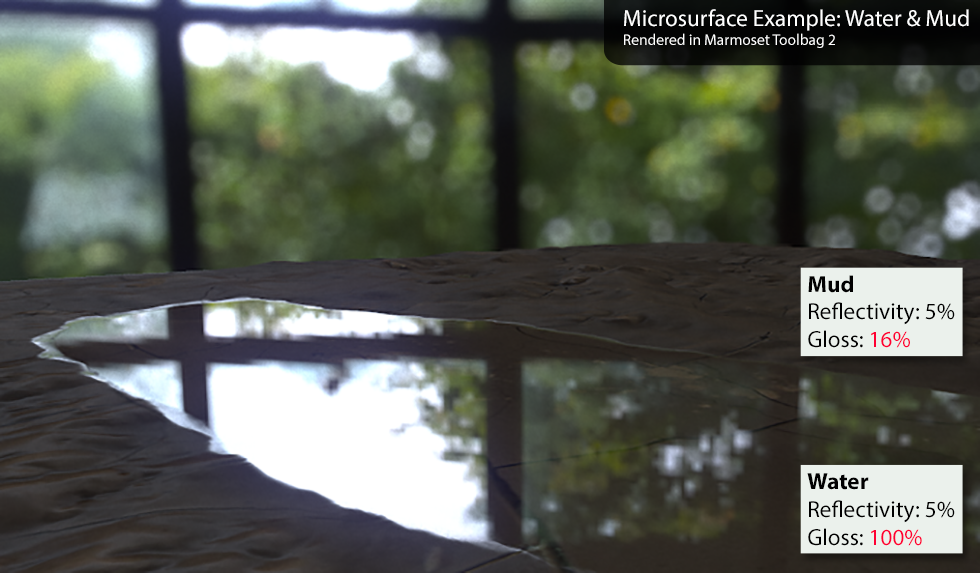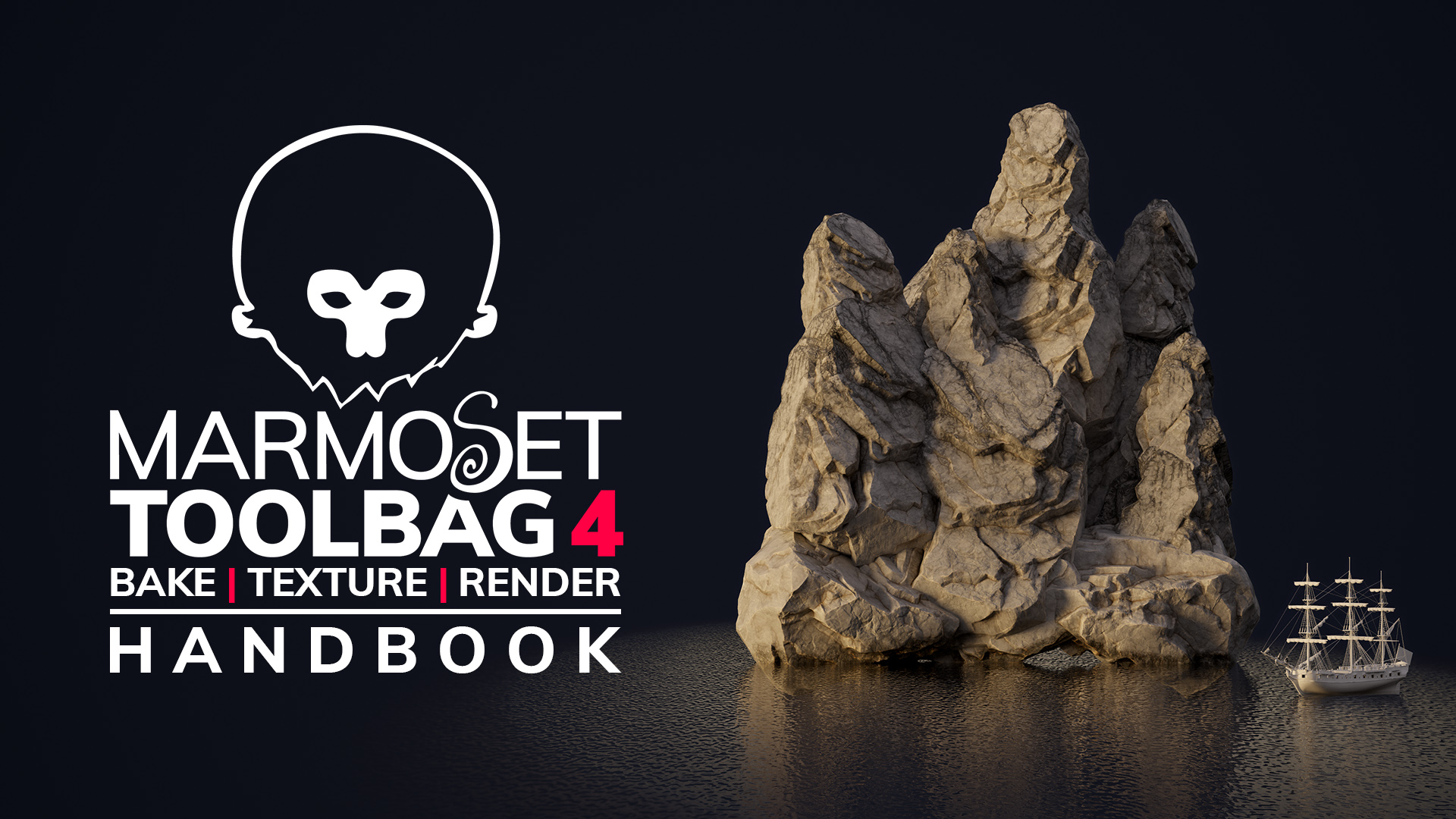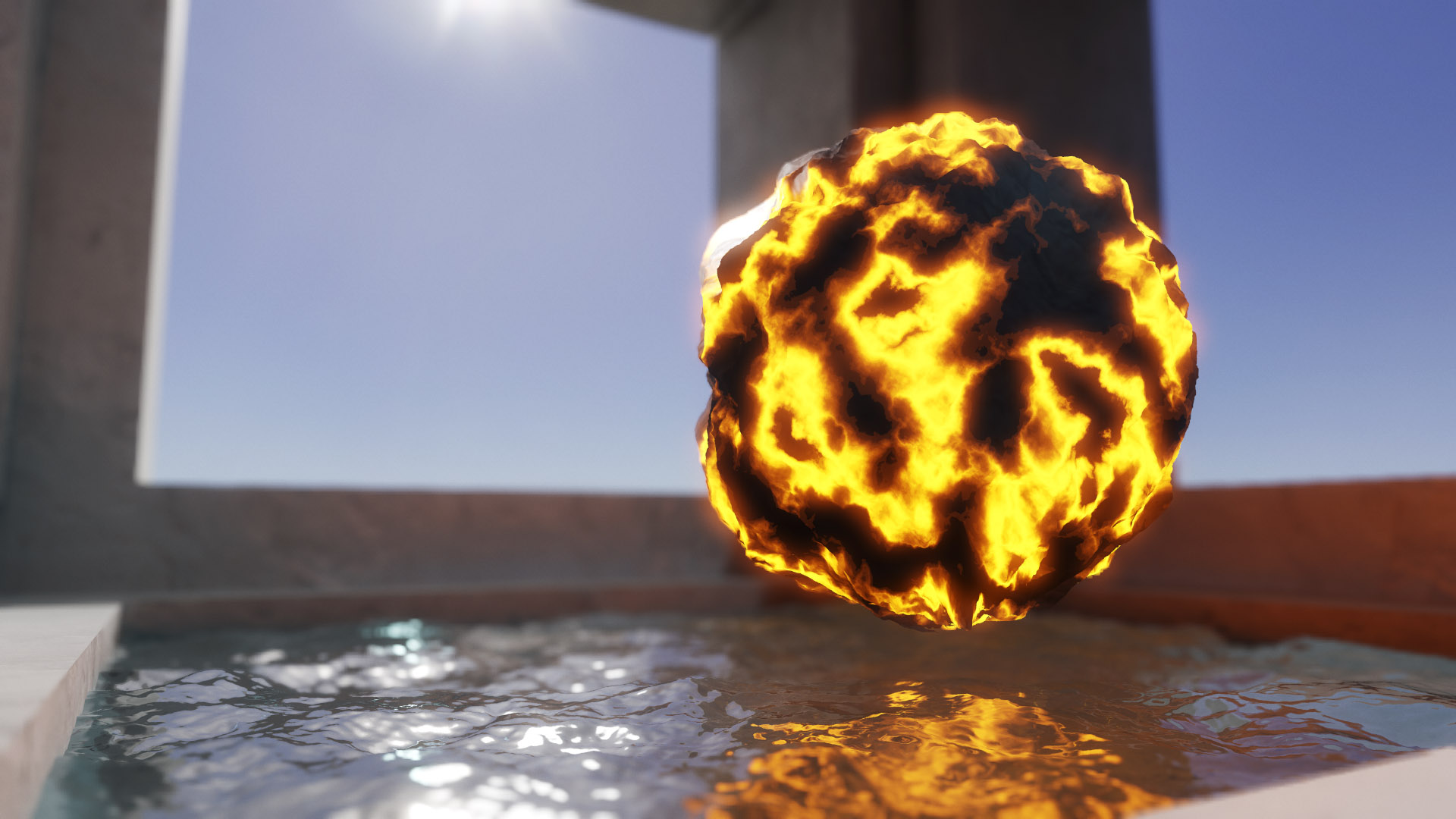Physically-based rendering (PBR) is an exciting, if loosely defined, trend in real time rendering lately. The term is bandied about a lot, often generating confusion as to what exactly it means. The short answer is: “many things”, and “it depends”, which is rather unsatisfying, so I have taken it upon myself to try to explain at some length what PBR represents and how it differs from older rendering methods. This document is intended for non-engineers (artists most likely), and will not present any mathematics or code.
Much of what makes a physically-based shading system different from its predecessors is a more detailed reasoning about the behavior of light and surfaces. Shading capabilities have advanced enough that some of the old approximations can now be safely discarded, and with them some of the old means of producing art. This means both the engineer and the artist should understand the motivations for these changes.
We’ll have to start with some of the basics so that they are well defined before we begin to highlight what is new, but if you’ll bear with me through the parts you may already know I think you’ll find it well worth the read. You may then want to also check out our own Joe Wilson’s article on creating PBR artwork.
Diffusion & Reflection
Diffusion and reflection – also known as “diffuse” and “specular” light respectively – are two terms describing the most basic separation of surface/light interactions. Most people will be familiar with these ideas on a practical level, but may not know how they are physically distinct.
When light hits a surface boundary some of it will reflect – that is, bounce off – from the surface and leave heading in a direction on the opposing side of the surface normal. This behavior is very similar to a ball thrown against the ground or a wall – it will bounce off at the opposite angle. On a smooth surface this will result in a mirror-like appearance. The word “specular”, often used to describe the effect, is derived from the latin for “mirror” (it seems “specularity” sounds less awkward than “mirrorness”).
Not all light reflects from a surface, however. Usually some will penetrate into the interior of the illuminated object. There it will either be absorbed by the material (usually converting to heat) or scattered internally. Some of this scattered light may make its way back out of the surface, then becoming visible once more to eyeballs and cameras. This is known by many names: “Diffuse Light”, “Diffusion”, “Subsurface Scattering” – all describe the same effect.
The absorption and scattering of diffuse light are often quite different for different wavelengths of light, which is what gives objects their color (e.g. if an object absorbs most light but scatters blue, it will appear blue). The scattering is often so uniformly chaotic that it can be said to appear the same from all directions – quite different from the case of a mirror! A shader using this approximation really just needs one input: “albedo”, a color which describes the fractions of various colors of light that will scatter back out of a surface. “Diffuse color” is a phrase sometimes used synonymously.
Translucency & Transparency
In some cases diffusion is more complicated – in materials that have wider scattering distances for example, like skin or wax. In these cases a simple color will usually not do, and the shading system must take into account the shape and thickness of the object being lit. If they are thin enough, such objects often see light scattering out the back side and can then be called translucent. If the diffusion is even lower yet (in for example, glass) then almost no scattering is evident at all and entire images can pass through an object from one side to another intact. These behaviors are different enough from the typical “close to the surface” diffusion that unique shaders are usually needed to simulate them.
Energy Conservation
With these descriptions we now have enough information to draw an important conclusion, which is that reflection and diffusion are mutually exclusive. This is because, in order for light to be diffused, light must first penetrate the surface (that is, fail to reflect). This is known in shading parlance as an example of “energy conservation”, which just means that the light leaving a surface is never any brighter than that which fell upon it originally.
This is easy to enforce in a shading system: one simply subtracts reflected light before allowing the diffuse shading to occur. This means highly reflective objects will show little to no diffuse light, simply because little to no light penetrates the surface, having been mostly reflected. The converse is also true: if an object has bright diffusion, it cannot be especially reflective.
Energy conservation of this sort is an important aspect of physically-based shading. It allows the artist to work with reflectivity and albedo values for a material without accidentally violating the laws of physics (which tends to look bad). While enforcing these constraints in code isn’t strictly necessary to producing good looking art, it does serve a useful role as a kind of “nanny physicist” that will prevent artwork from bending the rules too far or becoming inconsistent under different lighting conditions.
Metals
Electrically conductive materials, most notably metals, are deserving of special mention at this point for a few reasons.
Firstly, they tend to be much more reflective than insulators (non-conductors). Conductors will usually exhibit reflectivities as high as 60-90%, whereas insulators are generally much lower, in the 0-20% range. These high reflectivities prevent most light from reaching the interior and scattering, giving metals a very “shiny” look.
Secondly, reflectivity on conductors will sometimes vary across the visible spectrum, which means that their reflections appear tinted. This coloring of reflection is rare even among conductors, but it does occur in some everyday materials (e.g. gold, copper, and brass). Insulators as a general rule do not exhibit this effect, and their reflections are uncolored.
Finally, electrical conductors will usually absorb rather than scatter any light that penetrates the surface. This means that in theory conductors will not show any evidence of diffuse light. In practice however there are often oxides or other residues on the surface of a metal that will scatter some small amounts of light.
It is this duality between metals and just about everything else that leads some rendering systems to adopt “metalness” as a direct input. In such systems artists specify the degree to which a material behaves as a metal, rather than specifying only the albedo & reflectivity explicitly. This is sometimes preferred as a simpler means of creating materials, but is not necessarily a characteristic of physically-based rendering.
Fresnel
Augustin-Jean Fresnel seems to be one of those old dead white guys we are unlikely to forget, mainly because his name is plastered on a range of phenomena that he was the first to accurately describe. It would be hard to have a discussion on the reflection of light without his name coming up.
In computer graphics the word Fresnel refers to differing reflectivity that occurs at different angles. Specifically, light that lands on a surface at a grazing angle will be much more likely to reflect than that which hits a surface dead-on. This means that objects rendered with a proper Fresnel effect will appear to have brighter reflections near the edges. Most of us have been familiar with this for a while now, and its presence in computer graphics is not new. However, PBR shaders have made popular a few important corrections in the evaluation of Fresnel’s equations.
The first is that for all materials, reflectivity becomes total for grazing angles – the “edges” viewed on any smooth object should act as perfect (uncolored) mirrors, no matter the material. Yes, really – any substance can act as a perfect mirror if it is smooth and viewed at the right angle! This can be counterintuitive, but the physics are clear.
The second observation about Fresnel properties is that the curve or gradient between the angles does not vary much from material to material. Metals are the most divergent, but they too can be accounted for analytically.
What this means for us is that, assuming realism is desired, artist control over Fresnel behavior should generally be reduced, rather than expanded. Or at the very least, we now know where to set our default values!
This is good news of a sort, because it can simplify content generation. The shading system can now handle the Fresnel effect almost entirely on its own; it has only to consult some of the other pre-existing material properties, such as gloss and reflectivity.
A PBR workflow has the artist specify, by one means or another, a “base reflectivity”. This provides the minimum amount and color of light reflected. The Fresnel effect, once rendered, will add reflectivity on top of the artist specified value, reaching up to 100% (white) at glancing angles. Essentially the content describes the base, and Fresnel’s equations take over from there, making the surface more reflective at various angles as needed.
There is one big caveat for the Fresnel effect – it quickly becomes less evident as surfaces become less smooth. More information on this interaction will be given a bit later on.
Microsurface
The above descriptions of reflection and diffusion both depend on the orientation of the surface. On a large scale, this is supplied by the shape of the mesh being rendered, which may also make use of a normal map to describe smaller details. With this information any rendering system can go to town, rendering diffusion and reflection quite well.
However, there is one big piece still missing. Most real-world surfaces have very small imperfections: tiny grooves, cracks, and lumps too little for the eye to see, and much too small to represent in a normal map of any sane resolution. Despite being invisible to the naked eye, these microscopic features nonetheless affect the diffusion and reflection of light.
Microsurface detail has the most noticeable effect on reflection (subsurface diffusion is not greatly affected and won’t be discussed further here). In the diagram above, you can see parallel lines of incoming light begin to diverge when reflected from a rougher surface, as each ray hits a part of the surface with a different orientation. The analog in the ball/wall analogy would be a cliffside or something similarly uneven: the ball is still going to bounce off but at an unpredictable angle. In short, the rougher the surface gets, the more the reflected light will diverge or appear “blurry”.
Unfortunately, evaluating each microsurface feature for shading would be prohibitive in terms of art production, memory use, and computation. So what are we to do? It turns out if we give up on describing microsurface detail directly and instead specify a general measure of roughness, we can write fairly accurate shaders that produce similar results. This measure is often referred to as “Gloss”, “Smoothness”, or “Roughness”. It can be specified as a texture or as a constant for a given material.
This microsurface detail is a very important characteristic for any material, as the real world is full of a wide variety of microsurface features. Gloss mapping is not a new concept, but it does play a pivotal role in physically-based shading since microsurface detail has such a big effect on light reflection. As we will soon see, there are several considerations relating to microsurface properties that a PBR shading system improves upon.
Energy Conservation (Again)
As our hypothetical shading system is now taking microsurface detail into account, and spreading reflected light appropriately, it must take care to reflect the correct amount of light. Regrettably, many older rendering systems got this wrong, reflecting too much or too little light, depending on the microsurface roughness.
When the equations are properly balanced, a renderer should display rough surfaces as having larger reflection highlights which appear dimmer than the smaller, sharper highlights of a smooth surface. It is this apparent difference in brightness that is key: both materials are reflecting the same amount of light, but the rougher surface is spreading it out in different directions, whereas the smoother surface is reflecting a more concentrated “beam”:
Here we have a second form of energy conservation that must be maintained, in addition to the diffusion/reflection balance described earlier. Getting this right is one of the more important points required for any renderer aspiring to be “physically-based”.
All Hail Microsurface
And it is with the above knowledge that we come to a realization, a big one actually: microsurface gloss directly affects the apparent brightness of reflections. This means an artist can paint variations directly into the gloss map – scratches, dents, abraded or polished areas, whatever – and a PBR system will display not just the change in reflection shape, but relative intensity as well. No “spec mask”/reflectivity changes required!
This is significant because two real world quantities that are physically related – microsurface detail and reflectivity – are now properly tied together in the art content and rendering process for the first time. This is much like the diffusion/reflection balancing act described earlier: we could be authoring both values independently, but since they are related, the task is only made more difficult by attempting to treat them separately.
Further, an investigation of real world materials will show that reflectivity values do not vary widely (see the earlier section on conductivity). A good example would be water and mud: both have very similar reflectivity, but since mud is quite rough and the surface of a puddle is very smooth, they appear very different in terms of their reflections. An artist creating such a scene in a PBR system would author the difference primarily through gloss or roughness maps rather than adjusting reflectivity, as shown below:

Microsurface properties have other subtle effects on reflection as well. For example, the “edges-are-brighter” Fresnel effect diminishes somewhat with rougher surfaces (the chaotic nature of a rough surface ‘scatters’ the Fresnel effect, preventing the viewer from being able to clearly resolve it). Further, large or concave microsurface features can “trap” light – causing it to reflect against the surface multiple times, increasing absorption and reducing brightness. Different rendering systems handle these details in different ways and to different extents, but the broad trend of rougher surfaces appearing dimmer is the same.
Conclusion
There is of course much more to say on the topic of physically-based rendering; this document has served only as a basic introduction. If you haven’t already, read Joe Wilson’s tutorial on creating PBR artwork. For those wanting more technical information, I could recommend several readings:
- John Hable’s excellent blog post: Everything Is Shiny
- John Hable’s even better blog post: Everything Has Fresnel
- Sébastien Lagarde’s summary of Rendering Remember Me
- Come to think of it, all of Sébastien Lagarde’s Blog is good stuff
- The SIGGRAPH 2010 course on PBR
- Always worth mentioning: The Importance of Being Linear
If there are any burning questions still left unanswered, I can usually be reached on twitter.










